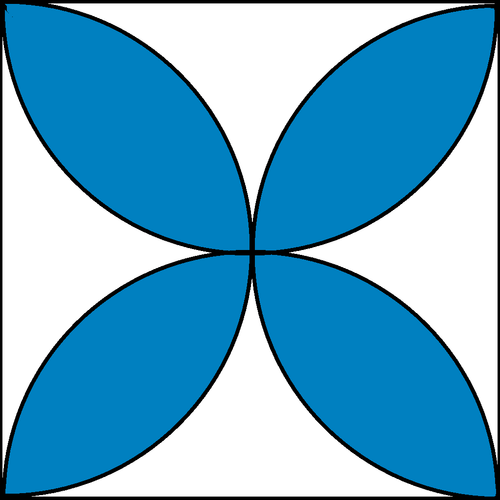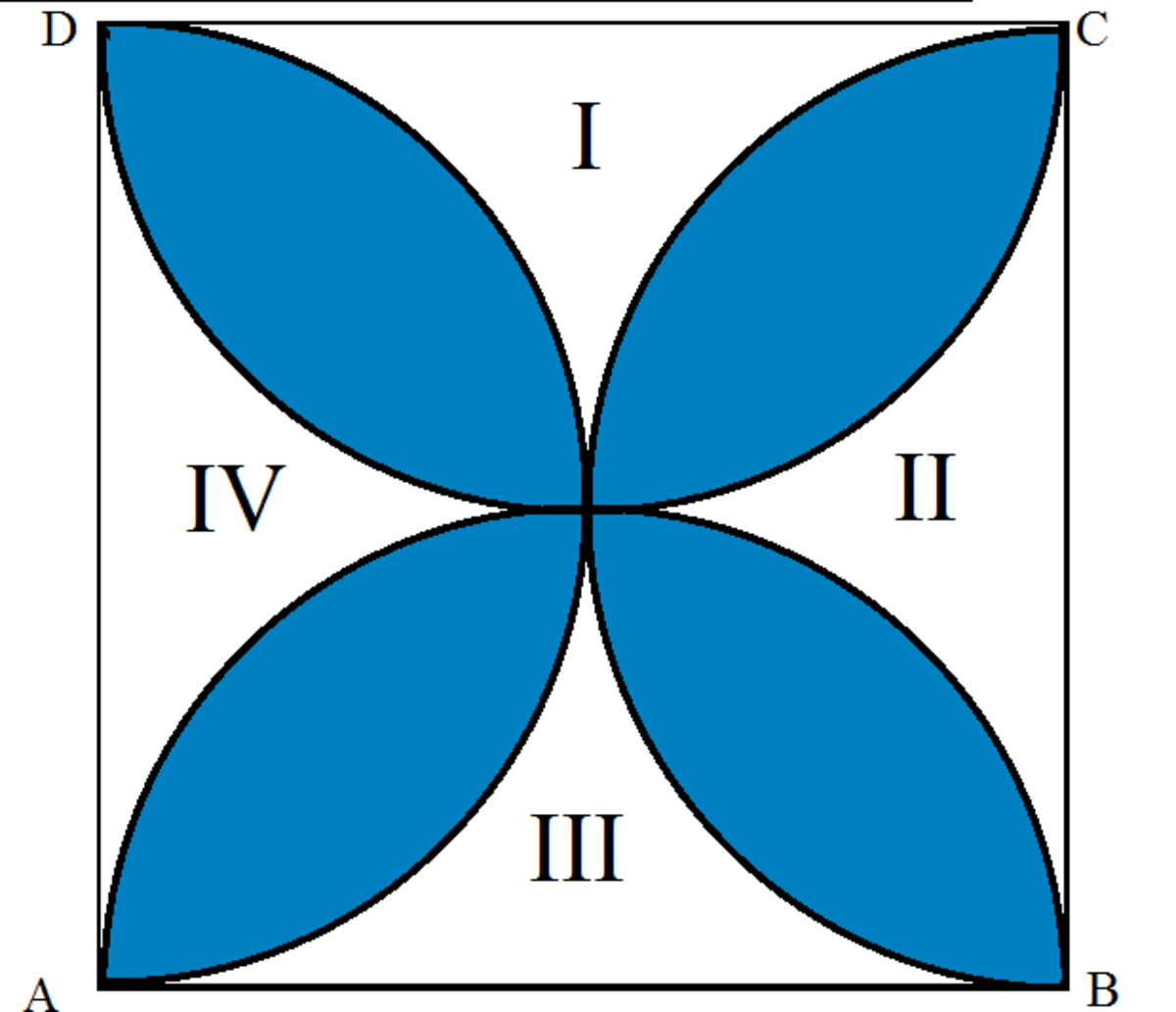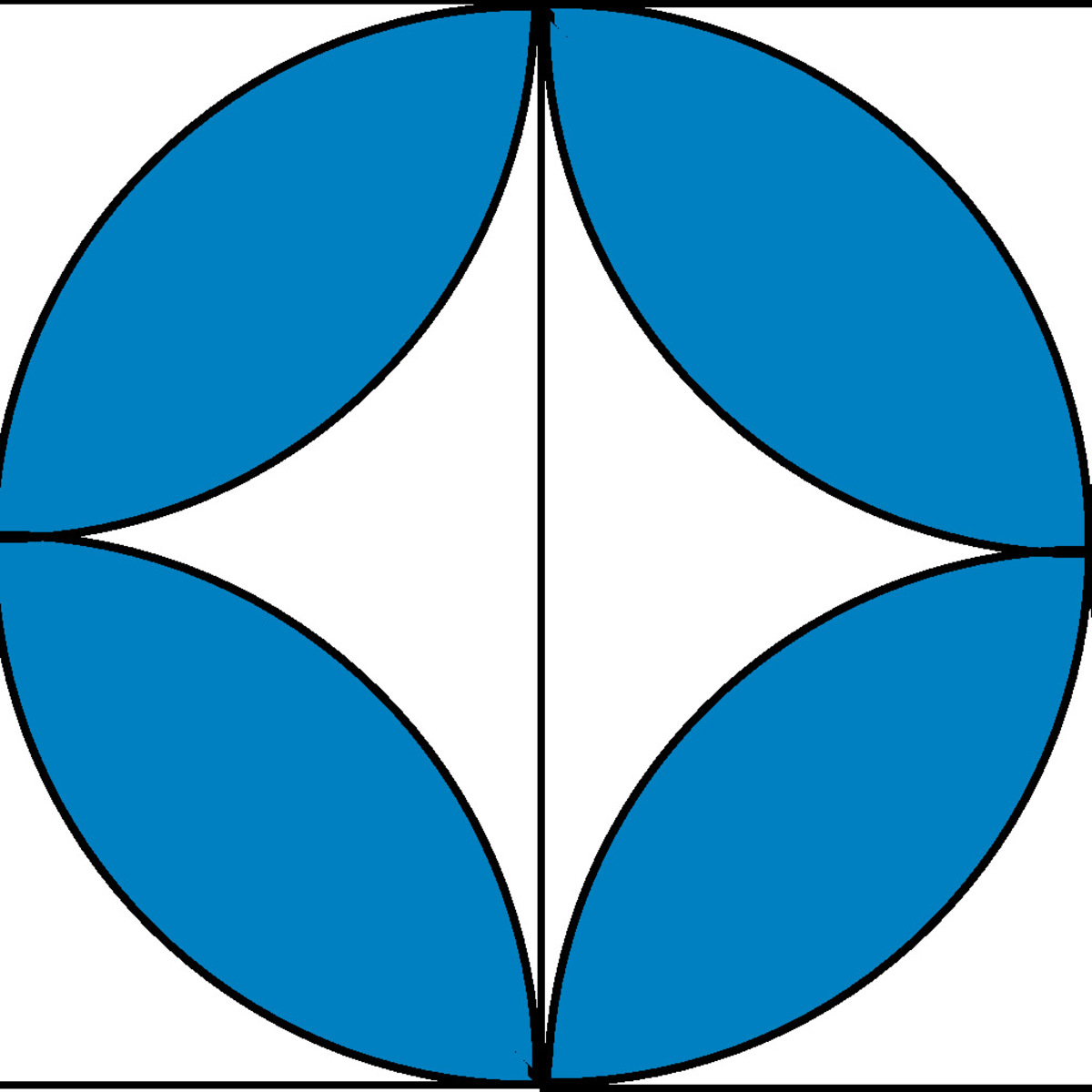Four Blue Leaf Clover?
 Find the area of the shaded portion if the side of the square measures
2
0
cm
.
Give the answer in
cm
2
. Use the approximation
π
=
3
.
1
4
Find the area of the shaded portion if the side of the square measures
2
0
cm
.
Give the answer in
cm
2
. Use the approximation
π
=
3
.
1
4
The answer is 228.
This section requires Javascript.
You are seeing this because something didn't load right. We suggest you, (a) try
refreshing the page, (b) enabling javascript if it is disabled on your browser and,
finally, (c)
loading the
non-javascript version of this page
. We're sorry about the hassle.
10 solutions
Excellent solution
woaahh. great..
Great solution
i did the same (exactly same)
The square consists of 4 blue parts and 4 white parts
It is easy to prove that the 4 blue parts are congruent and the 4 white are
congruent
Let the area of one blue part is denoted by x
Let the area of one white part is denoted by y
Area of the square = 400 = 4x + 4y
x + y = 100 ....................................... (1)
area of one semicircle = (1/2) Pi (10)^2 = 2x + y
2x + y = 157 .....................................(2)
From (1), (2) we get
x = 57
Then
Then required area = 4(57) = 228
I never thought this way ! wow.....
a bit lengthy but a quite different approach.. great job
i did exactly the same :D
Let us Mark the four un-shaded regions as I, II, III and IV.

The Total Area of the portions I and III =
Total Area of Square ABCD - area of semi-circle with diameter BC - area of semicircle with diameter AD
Area of Square = (20*20) cm^2 = 400 c m 2
Radius = 10 cm.
=[20 20 - (3.14 10^2 )/2 - (3.14*10^2)/2] c m 2
=[400 - 157 - 157] c m 2
=86 c m 2
Similarly, the area of Portions II and IV = 86 c m 2
Therefore Total Area of the Shaded Portion = Area of Square - Sum of Area of the shaded Portions ( Area ofI, II, III and IV)
Sum of Unshaded Portion = (86 +86) c m 2 = 172 c m 2
Area of Shaded Portion = (400 - 172) c m 2
Area of The Shaded Portion = 2 2 8 c m 2
First, find the area of the square, then imagine there is a ball/circle inside the square, afterwards find the area of the ball
Area of the square :
(S x S) ===> 20 x 20 = 400 cm^2
Area of the ball/circle:
(πr^2) ===> 3,14 x 10 x 10 = 314 cm^2
the inner and the outer area(white area) of the ball has the same broad. to determine the extent of its area, find outer area first, then multiply it by 2 (because they has the same broad)
Area of the square - area of the circle: 400 - 314 = 86 cm^2 then multiply it by two: 86 x 2 = 172 cm^2 so the inner + outer area is 172 cm^2
finally got the blue area by: Area of square - the inner n outer area of the ball (white area): 400 - 172 = 228 cm^2
The thing I love about calculus is that it works even if you're bad at geometry. This integral can be used to calculate the area of one "petal"... Multiply the answer by 4.
.
 *
The blank area outside the circle is obviously the same as the blank area inside the circle.
*
The blank area outside the circle is obviously the same as the blank area inside the circle.
>>if the complete square is 20x20= 400cm2 we can substract 86 cm2 for the blank area outside of the circle and then another 86cm2 for the blank area inside ;)
400-86-86=228
Area of each blue portion is always a constant 1/2pi-1=0.5708 ... As the radius of the circle is 10, the area of each blue part is 57.08 & this multiplied by 4 parts yields 228.32 sq cm, the precise area of the blue portion. The square is only ref having an area of 400 sq cm.
My solution is ( i dont know if it will be worth to, because im just a common student, please do correct mine if i were wrong): 1. Cut the pic and take it into a quarter of square. 2. Then use the area of the semicircle and minus it to the area of the triangle.
3. You will get a 1/8 of its overlapping semicircle so you have to times 8.
- (Nth to count)
- Area of the semicircle = 1/4 πr^2 = 1/4 3.14 10^2 = 78.5 Area of a quarter of triangle= 1/2 lh = 1/2 10 10 = 50 Then , minus it and you will get a result of 28.5
- Lastly you need to do is 28.5 x 8 = 228cm^2
i used that way too
Did it the same way, seems to be the easiest solution
Square - (Square - Circle) - (Square - Circle) = 2*Circle - Square
Isolate one quadrant of a circle...divide the shaded portion into 2 areas, making one circular segment.. Hence its area = r^2/2 ( theta - Sin theta )..The total area will be multiplied by 8...hence A = 8 x 10^2 /2 ( pi/2 -1 ) = 228 cm^2...note..theta = pi/2 radians and sin pi/2 =1
There is one square and 4 semicircles overlapping. If we consider one semicircle, it contains two shaded regions. And one shaded region is common between two shaded regions. So, if we calculate the area of all semicircles and add them, it will be: 4 ( (π * r^2)/2) = 628 sq cm. (Since all semicircles are of same radius) This area is nothing but: Area of unshaded region + 2 Area of shaded region And, area of square is nothing but: Area of unshaded region + Area of shaded region. So, if we subtract area of sqaure, which is 20*20 = 400 sq cm. from area of all semicircles, we will get our desired answer. Area of shaded region = 628 - 400 = 228 sq cm. Yay :)
Imagine the square as being made of 4 overlapping semicircles.
Area of 4 semicircles = 2πr^2 = 2×3.14×100 = 628cm^2.
Area of the square = 20×20cm = 400cm^2.
Area of the shaded region= Area of the four semicircles - Area of the square= 228cm^2